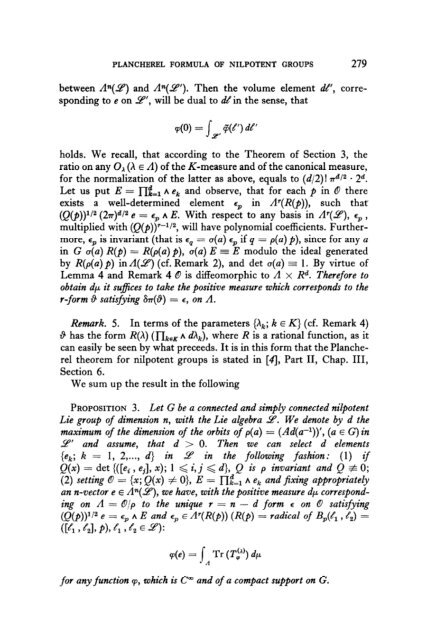On the Characters and the Plancherel Formula of Nilpotent Groups ...
On the Characters and the Plancherel Formula of Nilpotent Groups ...
On the Characters and the Plancherel Formula of Nilpotent Groups ...
You also want an ePaper? Increase the reach of your titles
YUMPU automatically turns print PDFs into web optimized ePapers that Google loves.
PLANCHERRL FORMULA OF NILPOTENT GROUPS 279<br />
between A”(9) <strong>and</strong> A”(Y). Then <strong>the</strong> volume element de’, corre-<br />
sponding to e on Y, will be dual to &in <strong>the</strong> sense, that<br />
holds. We recall, that according to <strong>the</strong> Theorem <strong>of</strong> Section 3, <strong>the</strong><br />
ratio on any OA (A E A) <strong>of</strong> <strong>the</strong> K-measure <strong>and</strong> <strong>of</strong> <strong>the</strong> canonical measure,<br />
for <strong>the</strong> normalization <strong>of</strong> <strong>the</strong> latter as above, equals to (d/2)! ~4~ * 2d.<br />
Let us put E = n$=i A ek <strong>and</strong> observe, that for each p in 0 <strong>the</strong>re<br />
exists a well-determined element cp in Ar(R(p)), such that<br />
(Q(p))ll” (2~‘)~/~ e = g A E. With respect to any basis in /I’(9), E?, ,<br />
multiplied with (Q(p)) r - lj2, will have polynomial coefficients. Fur<strong>the</strong>r-<br />
more, cp is invariant (that is l q = u(u) l r, if q = p(a) p), since for any a<br />
in G u(a) R(p) = R@(Q) p), u(a) E = E modulo <strong>the</strong> ideal generated<br />
by R(p(a)p) in A(9) (cf. R emark 2), <strong>and</strong> det ~(a) = 1. By virtue <strong>of</strong><br />
Lemma 4 <strong>and</strong> Remark 4 0 is diffeomorphic to A x Rd. Therefore to<br />
obtain dp it sufices to take <strong>the</strong> positive measure which corresponds to <strong>the</strong><br />
r-form 6 satisfying &~(a) = 4, on A.<br />
Remark. 5. In terms <strong>of</strong> <strong>the</strong> parameters {Ak; k E K) (cf. Remark 4)<br />
8 has <strong>the</strong> form R(h) (nksK A dh,), where R is a rational function, as it<br />
can easily be seen by what preceeds. It is in this form that <strong>the</strong> Planche-<br />
rel <strong>the</strong>orem for nilpotent groups is stated in [q, Part II, Chap. III,<br />
Section 6.<br />
We sum up <strong>the</strong> result in <strong>the</strong> following<br />
PROPOSITION 3. Let G be a connected <strong>and</strong> simply connected nilpotent<br />
Lie group <strong>of</strong> dimension n, with <strong>the</strong> Lie algebra 9. We denote by d <strong>the</strong><br />
7,ximum <strong>of</strong> <strong>the</strong> dimension <strong>of</strong> <strong>the</strong> orbits <strong>of</strong> p(a) = (Ad(a-l))‘, (a E G) in<br />
<strong>and</strong> assume, that d > 0. Then we can select d elements<br />
{e,; k = 1, 2,..., d} in<br />
Q(x) = det {([e, , e] 5 , x);l<br />
9 in<br />

















